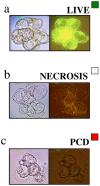The fusarium mycotoxin deoxynivalenol can inhibit plant apoptosis-like programmed cell death
- PMID: 23922734
- PMCID: PMC3724914
- DOI: 10.1371/journal.pone.0069542
The fusarium mycotoxin deoxynivalenol can inhibit plant apoptosis-like programmed cell death
Abstract
The Fusarium genus of fungi is responsible for commercially devastating crop diseases and the contamination of cereals with harmful mycotoxins. Fusarium mycotoxins aid infection, establishment, and spread of the fungus within the host plant. We investigated the effects of the Fusarium mycotoxin deoxynivalenol (DON) on the viability of Arabidopsis cells. Although it is known to trigger apoptosis in animal cells, DON treatment at low concentrations surprisingly did not kill these cells. On the contrary, we found that DON inhibited apoptosis-like programmed cell death (PCD) in Arabidopsis cells subjected to abiotic stress treatment in a manner independent of mitochondrial cytochrome c release. This suggested that Fusarium may utilise mycotoxins to suppress plant apoptosis-like PCD. To test this, we infected Arabidopsis cells with a wild type and a DON-minus mutant strain of F. graminearum and found that only the DON producing strain could inhibit death induced by heat treatment. These results indicate that mycotoxins may be capable of disarming plant apoptosis-like PCD and thereby suggest a novel way that some fungi can influence plant cell fate.
Conflict of interest statement
Figures






References
-
- Nganje WE, Bangsund DA, Leistritz FL, Wilson WW, Tiapo NM (2002) Estimating the economic impact of a crop disease: the case of Fusarium head blight in U.S. wheat and barley. In: 2002 National Fusarium Head Blight Forum, East Lansing: Michigan State University, 275–281.
-
- Goswami RS, Kistler HC (2004) Heading for disaster: Fusarium graminearum on cereal crops. Mol Plant Pathol 5: 515–525. - PubMed
-
- Visconti A, Pascale M (2010) An overview on Fusarium mycotoxins in the durum wheat pasta production chain. Cereal Chem 87: 21–27.
-
- Eudes F, Comeau A, Rioux S, Collin J (2001) Impact of trichothecenes on Fusarium head blight [Fusarium graminearum] development in spring wheat (Triticum aestivum). Can J Plant Pathol 23: 318–322.
-
- Bai GH, Desjardins AE, Plattner RD (2002) Deoxynivalenol-nonproducing Fusarium graminearum causes initial infection, but does not cause disease spread in wheat spikes. Mycopathologia 153, 91–98. - PubMed
Publication types
MeSH terms
Substances
LinkOut - more resources
Full Text Sources
Other Literature Sources

